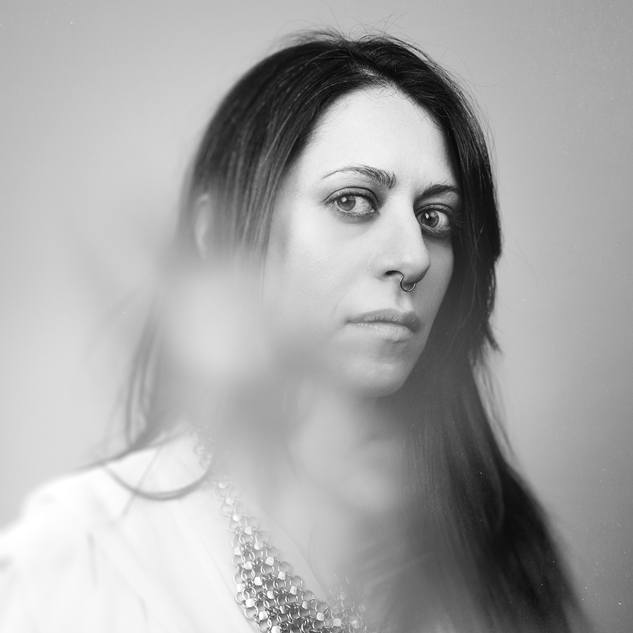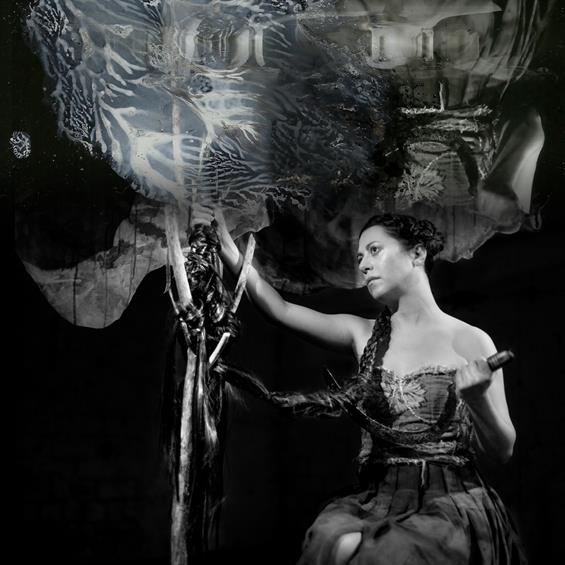Maud The Moth – „The Distaff“ (DE+ENG)

Zusammenfassung
Band: Maud The Moth
Album: „The Distaff“
Datum: 21.02.2025
Label: The Lavarium / La Rubia Producciones / Woodford Halse-Fenny Compton
Genre: Singer / Songwriter
Land: Spanien / Schottland
Order: HIER
Quelle: Rarely Unable
Cover und Tracklist

01. Canto de enramada
02. A temple by the river
03. Exuviae
04. Burial of the patriarchs
05. Siphonophores [video]
06. Despeñaperros
07. O Rubor
08. Fiat Lux
09. Kwisatz Haderach
Maud The Moth, das Soloprojekt der in Spanien geborenen und in Schottland lebenden Pianistin, Sängerin und Songwriterin Amaya Lopez-Carromero, kündigt ihr neues Album „The Distaff“ an, das über The Larvarium (digital +CD) und La Rubia Producciones (Vinyl) veröffentlicht wird, wobei Woodford Halse/Fenny Compton am 21. Februar 2025 eine Tape-Veröffentlichung beisteuern werden.
Amaya benutzt seit langem den Mantel von Maud, der Motte, als Alter Ego, als eine Art Séance, um Themen wie Wurzellosigkeit, Identität und Trauma zu erforschen. Der Spinnrocken bezieht sich insbesondere auf den Stock oder die Spindel, auf die Wolle oder Flachs zum Spinnen aufgewickelt wird, und ist ein Objekt, das historisch in vielen Kulturen als Symbol für die „tugendhafte Frau“ verwendet wurde, ein autoritäres Ideal, um das sich ein Großteil des Traumas rund um das Weibliche rankt. Das Album hat die Form einer selbstreflexiven und surrealen Autobiografie. Es wurde zum Teil durch das gleichnamige Gedicht der griechischen Dichterin Erinna inspiriert, in dem sie den Verlust der Individualität und der Handlungsfähigkeit ihrer Freundin im Tausch gegen die Ehe – und damit die Sicherheit und Akzeptanz in den Augen der Gesellschaft – beklagt.
Das Album existiert in einer ätherischen, aber gewalttätigen Welt ästhetischer Überschneidungen, in der die Zeit stillsteht und fiktiver und neu erfundener Folk mit der üblichen Klangmenagerie von Maud The Moth am Tisch sitzt. Es ist das Ergebnis einer lebenslangen Besessenheit von Klang und Musik, wobei Einblicke in musikalische Genres Einblicke in Amayas künstlerische Interessen und ihre Teilnahme an der europäischen Underground-Szene über viele Jahre hinweg, in Bands wie Healthyliving, bieten. Es ist schwerer, dunkler und exponierter als alle ihre früheren Werke und wird von einigen hochkarätigen Künstlern wie Seb Rochford (Patti Smith, Polar Bear, Sons of Kemet, Pulled by magnets, etc.) am Schlagzeug, Alison Chesley (Helen Money) am Cello, Fay Guiffo an der Violine und Scott McLean (Ashenspire, healthyliving, Falloch) an Gitarre, Saxophon und Synthesizer begleitet.
Maud The Moth veröffentlicht das Video zu „Siphonophores“. Über den Track sagt Maud: „Ich habe „Siphonophores“ auf der Gitarre geschrieben, während des ersten Lockdowns, einer Zeit, in der ich irgendwie zwischen einer fast leeren Wohnung in Edinburgh und Dresden gefangen war. Es war eine unglaublich erschütternde Zeit, aber auch eine Zeit der Hoffnung, in der wichtige neue Dinge geboren wurden. Ich fühlte mich unglaublich sensibel für alles, fast so, als würde das Leben in Zeitlupe ablaufen. Ich bin kein sicherer Gitarrist, da ich mir alles selbst beigebracht habe, aber wahrscheinlich deshalb habe ich das Gefühl, dass dieses Instrument mir erlaubt, mich auf Aspekte des Songwritings zu konzentrieren, die ich normalerweise übersehe, wenn ich am Klavier schreibe, und ich denke, dass es ein notwendiger Schritt war, damit dieser Song existieren konnte. Etwas anderes, das ich in letzter Zeit wirklich ausgenutzt habe und das auf dem Album stark zum Tragen kommt, sind die perkussiven Fähigkeiten des Klaviers und insbesondere des Sustain-Pedals, wenn es mit dem Mikrofon abgenommen wird. Das kann man am Anfang von „Siphonophores“ sehr deutlich hören.„
Die Filmografin Elena Brea fügt hinzu: „Die Kreation ist ein visueller Ausdruck der verschiedenen Stadien der Selbstreflexion, wenn wir dieser Last und Last, die wir tragen, begegnen, dagegen ankämpfen und sie überwinden. Von Unwissenheit und Verleugnung über Aufregung, Schock und Schmerz bis hin zu Verschlucken, Akzeptanz und Vergebung, um all diese Teile von uns selbst zu umarmen und Frieden auf dem Weg zur Selbstfindung, Selbstliebe und Selbstfürsorge zu erreichen, anstatt zu gering und vernachlässigt.“
Geschrieben und arrangiert von Amaya, mit einigen Beiträgen in der späteren Rolle von den oben genannten Kollaborateuren, präsentiert das Album neun Tracks, die ursprünglich vollständig auf dem akustischen Klavier als begleitete Gesangsstücke geschrieben wurden, in reiner Singer-Songwriter-Manier. Das Album wurde von Scott und Amaya zwischen Januar und Juli 2024 in verschiedenen Studios in ganz Großbritannien co-produziert und aufgenommen, in einem Prozess, der kurz nach der Pandemie 2020 begann und neben den Albumaufnahmen in einem detaillierten, organischen und manchmal obsessiven Prozess endete, der in erster Linie darauf abzielte, die natürliche Dynamik und den Ausdruck der freien Performance einzufangen. The Distaff wurde komplett von Scott gemischt und in Abbey Road von Alex Wharton (Radiohead, My Bloody Valentine, Aurora, Kathryn Joseph etc.) gemastert.
Obwohl das Album aus einer sehr persönlichen Sichtweise geboren wurde, fehlt es an einem spezifischen Erzähler und es wurde fast wie eine klangliche Aussteuer konzipiert, in der die Nadelspitze, Seide und andere Familienerbstücke gegen unvorhersehbare Erinnerungen an das ländliche Spanien durch die Weinberge, Familienstreitigkeiten, alte Geschichten von Kriegsleiden, Generationenbrüche und schließlich den Konflikt von Migration und Entfremdung ausgetauscht wurden.
Die Songs zeichnen dystopische pastorale Szenen, die sich über die Zeitspanne eines fiktiven Tages außerhalb von Zeit und kohärenten Orten entwickeln und in denen die Vorstellungskraft (oft der einzige Bericht, der von traumatischen Ereignissen und Gaslighting überlebt hat) nicht mehr von Fakten zu unterscheiden ist.
„The Distaff“ versucht, vergangene Traumata anzuerkennen, einige der schwierigeren Aspekte, die zu unserem dunkleren Selbst beigetragen haben, zu verstehen und zu verarbeiten und durch kreative Katharsis Abschluss und Trost zu bieten.
Maud the moth, the solo project of Spanish-born and Scotland-based pianist, singer and songwriter Amaya Lopez-Carromero announces her new album, The Distaff, to be released via The Larvarium (digital +CD) and La Rubia Producciones (vinyl), with Woodford Halse/Fenny Compton contributing a tape release on 21st February 2025.
Amaya has long used the mantle of Maud the moth as an alter-ego, a séance-like conduit to explore themes of rootlessness, identity and trauma. The Distaff in particular refers to the stick or spindle onto which wool or flax is wound for spinning, and an object which has historically been used across multiple cultures as a symbol wielded by the “virtuous woman”, an authoritarian ideal around which much of the trauma surrounding the feminine coalesces. The album takes the form of a sort of self reflective and surreal autobiography. It was in part inspired by the poem of the same name written by the Greek poet Erinna, as she mourns her friend’s loss of individuality and agency in exchange for marriage – and therefore safety and acceptance in the eyes of society.
The album exists in an ethereal but violent world of aesthetic overlaps where time stands still and fictional and reimagined folk sits at the table with Maud the moth’s usual sonic menagerie. It is the result of a lifetime of obsession with sound and music, where glimpses of musical genre offer insight into Amaya’s artistic interests and her participation in the underground European scene for many years, in bands such as healthyliving. Heavier, darker, and more exposed than any of her previous works it features some highly accomplished artists, such as Seb Rochford (Patti Smith, Polar Bear, Sons of Kemet, Pulled by magnets, etc.) on drums, Alison Chesley (Helen Money) on cello, Fay Guiffo on violin and Scott McLean (Ashenspire, healthyliving, Falloch) on guitar, saxophone and synthesiser.
Maud the moth shares the video for „Siphonophores“. About the track, Maud the moth says; „I wrote „Siphonophores“ on guitar, during the first lockdown, a period where I was kind of trapped between an almost empty flat in Edinburgh and Dresden. It was an incredibly harrowing time, but also one of hope and where important new things were being birthed. I felt incredibly sensitive to everything, almost like life was happening in slow motion. I´m not a confident guitarist since I am completely self-taught, but, probably because of this, I feel that this instrument allows me to focus on aspects of the songwriting that I normally overlook when writing on piano, and I think it was a necessary step for this song to exist.
Something else which I’ve been really exploiting lately and features strongly in the album is the percussive capabilities of the piano, and in particular, of the sustain pedal when mic’d up. This can be heard very clearly at the beginning of „Siphonophores“.„
Filmographer Elena Brea adds; „The creation is a visual expression of the different stages of self-introspection when meeting, fighting and overcoming this burden and load we bare. From unawareness and denial, to agitation, shock and pain, to then ingestion, acceptance and forgiveness, to embrace all these parts of ourselves and reach peace in the path towards self discovery, self love and self care, instead of slight & neglect.„
Written and arranged by Amaya, with some contributions in the later role from the aforementioned collaborators, the album presents nine tracks originally written entirely on acoustic piano as accompanied voice pieces, in pure singer-songwriter fashion. The album was co-produced and recorded by Scott and Amaya in different studios across the UK between January and July of 2024, in a process that started shortly after the 2020 pandemic and finished alongside the album recordings in a detailed, organic and at times obsessive process aimed primarily at capturing the natural dynamics and expression of free performance. The Distaff was mixed in its entirety by Scott and mastered at Abbey Road by Alex Wharton (Radiohead, My Bloody Valentine, Aurora, Kathryn Joseph etc.)
Despite being born of a very personal point of view, the album lacks a specific narrator and was conceived almost as a sonic trousseau, where the needle point, silks and other family heirlooms have been swapped for out-of-the-corner-of-the-eye memories of rural Spain by the vineyards, family disputes, old tales of wartime pains, generational breaches and finally the conflict of migration and estrangement.
The songs paint dystopian pastoral scenes which evolve throughout the span of one fictional day outside of time and coherent locations and where imagination (often the only account surviving from traumatic events and gaslighting) has become indistinguishable from fact.
„The Distaff“ attempts to acknowledge past trauma, comprehend and process some of the more difficult aspects which have contributed to our darker self and offer closure and solace through creative catharsis.
